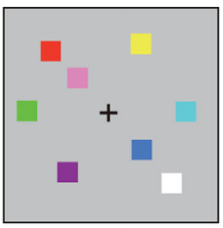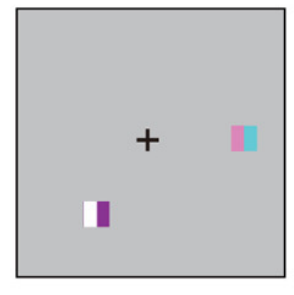Visual working memory (VWM) refers to our ability to hold in memory, for relatively brief amounts of time, an array of arbitrary shapes or colors that are not easily verbalized. For example, consider the stimulus below:

When this is shown for 1/10th of a second, and is then replaced by a blank screen or some other stimulus, people perform above chance on a subsequent memory test in which they are asked to recall the color of a randomly chosen square.
We can be quite confident that this form of memory is visual—as opposed to verbal—because the limited presentation duration does not allow for verbal recoding of the stimulus, and because in other experiments nonsense shapes are used that are even more difficult to verbalize.
One intriguing aspect of VWM is that it seems to be involved even when, strictly speaking, there is no requirement for an actual memory. That is, imagine the above stimulus being replaced immediately—with no retention interval—by the following test stimulus:

The participants’ task is to choose the color of the square from the two alternatives in the probe by pressing one of two buttons (only one probe is presented in the actual experiment).
When performance on this “memory-free” variant of the task is compared with performance in another condition in which there is delay of around 1 second between study and test, the correlation between the two types of task around individuals is at least 0.8 and can be as high as 0.92. This result suggests that VWM operates not only when stimuli disappear but also when they remain present.
If VWM operates when stimuli are present—a mode known as “online” processing—an immediate question concerns its ability to update those representations if the world changes. In other words, suppose you watch the above display but the squares continually wander across the screen—how does VWM deal with the constant need for updating?
A recent article in the Psychonomic Bulletin & Review addressed this question. Researchers Halely Balaban, Trafton Drew, and Roy Luria hypothesized that while VWM is typically flexible enough to handle continuous updating, there are certain changes in the world that cannot be integrated into existing representations. Balaban and colleagues argued that in such circumstances a resetting process is triggered, with VWM being cleared of existing content and starting anew.
Balaban and colleagues triggered resetting in a task in which people watched polygons move across the screen, such as in the figure below:

In the “reset” condition, one of the moving polygons all of a sudden split into two halves that continued to move separately. Because the object identity was disrupted, with neither half corresponding to any previously-encoded item, VWM ceased to update but instead reset itself—that is, it re-encoded the new set of shapes and continued to track them from then on.
In an earlier study, Balaban and colleagues found neural evidence for this resetting process (not relevant here) and also identified a behavioural signature of the resetting process: when participants were asked to detect an abrupt shape-change of a polygon (unrelated to the splitting into two objects), VWM was found to be blind to such changes around the time of the presumed reset. Changes that occurred before or after the presumed reset, however, were accurately detected.
The present study probed the resetting idea further, asking whether resetting wiped out all the active representations or whether it only removed the representation whose mapping was lost during the split of the polygon.
Balaban and colleagues addressed this question by focusing on people’s ability to detect shape-changes in the unseparated polygons—that is, those that kept moving as an integrated unit even after another polygon separated into halves. If resetting is global, then those shape changes should also be missed, whereas if resetting involves only the separating item, then shape changes of unseparating items should not escape detection.
Participants watched a moving display of polygons (the movement is indicated by the arrows in the above figure) and reported whether a polygon had changed shape (by half the polygon being replaced by another half-shape) after the movement was complete. Irrespective of whether or not a polygon changed shape, on half the trials a polygon also separated. The variables of greatest interest were the identity of the separating polygon (the one that also changed shape or another one) and the time at which the change took place relative to the time of separation. The figure below shows the results:

The results are unambiguous: change detection was unaffected by separation when there was no separation (that’s unsurprising!) or when the change was in a polygon that did not undergo separation. When the change involved the separating polygon, it was also detected but only when the change did not coincide with separation. When change and separation occurred synchronously, the change was missed most of the time.
The robustness of these results was underscored in two ways: First, Balaban and colleagues replicated the results in another study with a slight variation in procedure. Second, the pattern was remarkably consistent across participants from both experiments. As shown in the figure below, a behavioural cost of separation was observed for every single one of the 40 participants:

(Note that in this figure the X-axis does not represent time but the three conditions represented by different lines in the first figure above).
The fact that VWM can selectively “reset” information from memory is remarkable because it implies that specific information can be targeted for removal from memory while other information is retained unchanged. This result mirrors other data obtained in a different paradigm with verbal memories.
The presence of a removal mechanism should not surprise us in light of the fact that VWM is capacity limited: any system that can only hold a few items in memory must be agile indeed, and in particular, it must have access to a mechanism that efficiently discards no-longer-relevant information.
Psychonomics article focused on in this post:
Balaban, H., Drew, T., & Luria, R. (2018). Visual working memory can selectively reset a subset of its representations. Psychonomic Bulletin & Review, 25, 1877-1883. DOI: 10.3758/s13423-017-1400-y.
